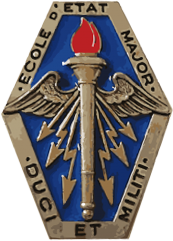The multilingual contents of the site are the result of an automatic translation.
EEM
Staff College

Presentation
History of the Staff College
In 1766, the Duke of Choiseul decided the creation of a "higher court of war and staff officers". The seat was set in Grenoble and the first director of the first training school for staff officers was Lieutenant-General Pierre de Bourcet. This designation proved to be very judicious because Bourcet, successively artilleryman, infantryman, engineer and geographer engineer, chief of staff in the armies during the Seven Years' War, wrote a memoir in 1762 on "the need to train officers with knowledge of the country".
The studies lasted three years and included a great deal of extended field knowledge, which was very expensive for the trainees, who had to maintain the crews needed for their incessant peregrinations.
Many officers, trained by Bourcet's course, will distinguish themselves in their staff training during the American War of Independence and the campaigns of the revolution. The best known is Berthier, Chief of Staff of the National Guard, of Bonaparte and then of Napoleon until 1814.
In 1818, Marshal Saint-Cyr created the staff application school. Located in the Sens district, rue de Grenelle, the school recruited officers as soon as they left the special military school and integrated them into a closed corps, known as the "corps d'état-major", which they left only to reach the rank of general officer.
The uniform is distinguished by the wearing of aiguillettes, a transformation of the cord tied to a pencil and attached to the shoulder, indispensable to the staff officer on horseback to transcribe and carry orders.
This school, which trained 1,700 staff officers during its sixty-three promotions, counts among its former students a President of the Republic, Marshal Mac Mahon, a head of government, General Trochu, four ministers of war, two other marshals of France (Pélissier, Lyautey), five commanders-in-chief and one hundred and twenty generals.
In 1876, the creation of the Ecole Militaire Supérieure, which in 1880 became the Ecole Supérieure de Guerre, led to its closure and the disappearance of the staff corps.
The principle of a permanent staff school was abandoned. Staff service was taught at the War College, except during periods of war, when it was closed. A staff course is then established:
. Senlis course during the 1914-1918 war to train officers fit for employment in a large unit staff in the field (from 21 November 1916 to May 1919),
. Staff courses in Compiègne, from 20 March to 19 May 1940; these courses were resumed in 1942 in Royat, Avignon, Algiers, Rabat and Hue. All the trainees formed what was later called the first promotion. From June 1943 to December 1944, courses lasting from four to six months were organised in Rabat, and in December 1944 the staff officers' training centre was set up at the military school for six-month courses, with trainees designated on the proposal of the chiefs of corps.
. Staff courses in Compiègne, from 20 March to 19 May 1940; these courses were resumed in 1942 in Royat, Avignon, Algiers, Rabat and Hue. All the trainees formed what was later called the first promotion. From June 1943 to December 1944, courses lasting from four to six months were organised in Rabat, and in December 1944 the staff officers' training centre was set up at the military school for six-month courses, with trainees designated on the proposal of the chiefs of corps.
In October 1946, the staff school was officially opened in Paris, starting with the eighth class of staff courses. But the organisation evolved once again and the ninth class, recruited through a competitive examination, completed a nine-month training course preceded by preparatory courses in the various military academies. This system lasted until 1965, when, the competitive examination having been abolished, the officers appointed to make up the 27th promotion completed a five-month internship whose purpose was thus defined:
"To train officers capable of holding executive positions in a staff".

The Staff College continued to operate in this way until the first semester of 1973, when the last group internship in Paris was carried out for the 43rd class, which saw its internship reduced to two months.
Indeed, from the 44th to the 51st promotion, joint and staff training, which was reduced to two months, was decentralized to the schools of arms application. However, the staff school retained a coordinating role and overall responsibility for primary military education. All officers admitted to the captain's course were admitted to the school and a final examination was held to certify their studies. This system was abandoned in 1977.
As part of the reorganisation of higher military education, the staff school, whose objectives had been brought up to the right level, opened its doors in Compiègne in February 1980 to officers who had passed the entrance examination and who made up the 52nd promotion.
The reorganization of the army, which began in 2008, led to the transfer of the staff school to its new garrison in Saumur on 1 July 2012.
Thus, the 175 captains, including 12 foreigners from the 129th promotion, have joined the Bessières district of the Saumur military academies (EMS).
Alongside the staff diploma, the school has over the years acquired new skills which enable it to offer other courses. For example, training courses in staff techniques (FTEM), aimed both at officers under specialist contract and at non-commissioned officers assigned to staff for the first time, are organised several times a year.
In 2008 the DAEOS (Diplôme d'Aptitude aux Emplois d'Officier Supérieur) was created. This diploma of the first degree of higher education is accessible to captains of the army's corps of arms officers who have been recognised as fit to serve as a senior officer.
Since the summer of 2014, the single DWS has been replaced by three individualized staff courses differentiated by their duration, level of ambition and the professional path that trainees have chosen to follow for their second half of their career.





